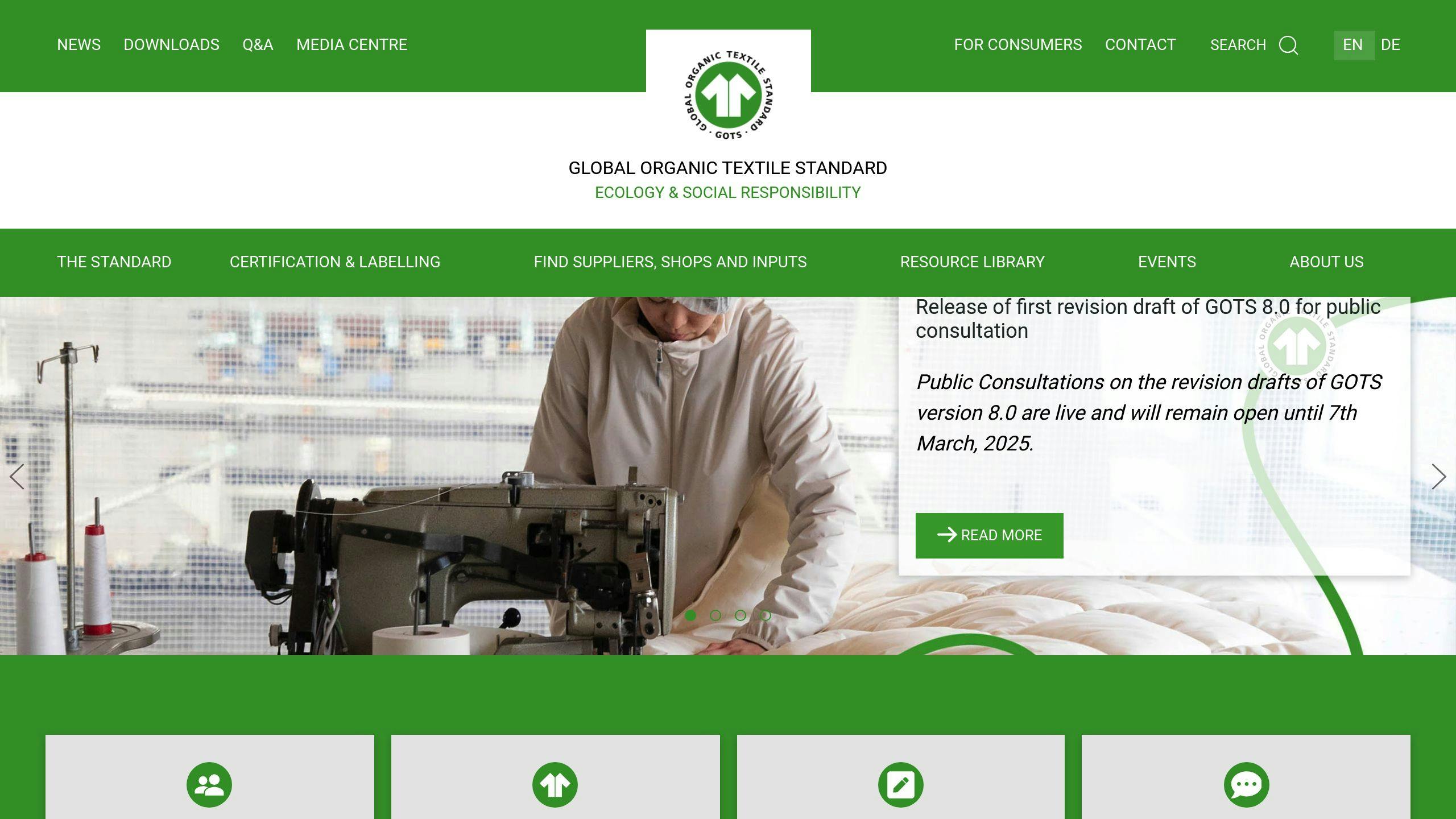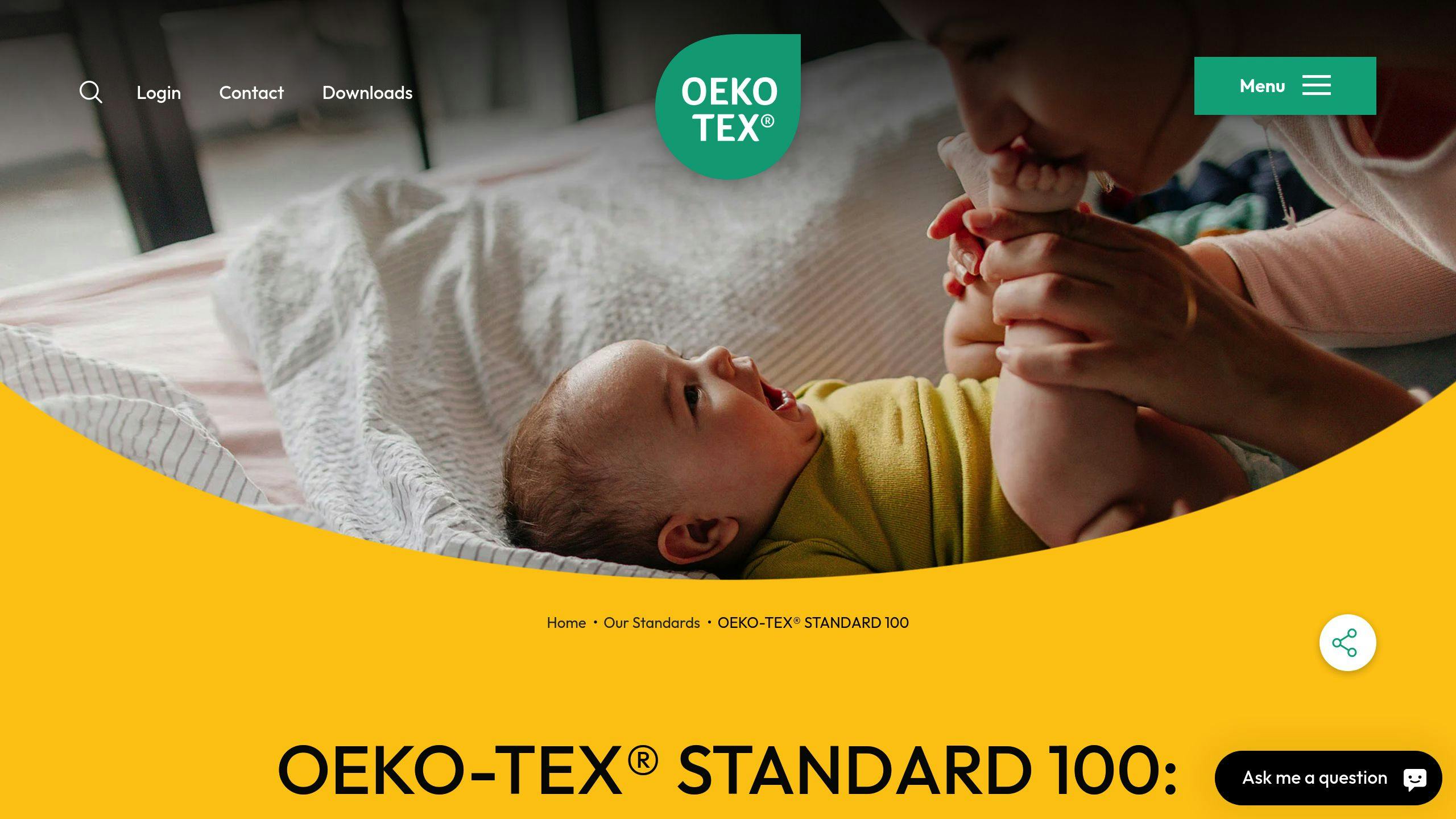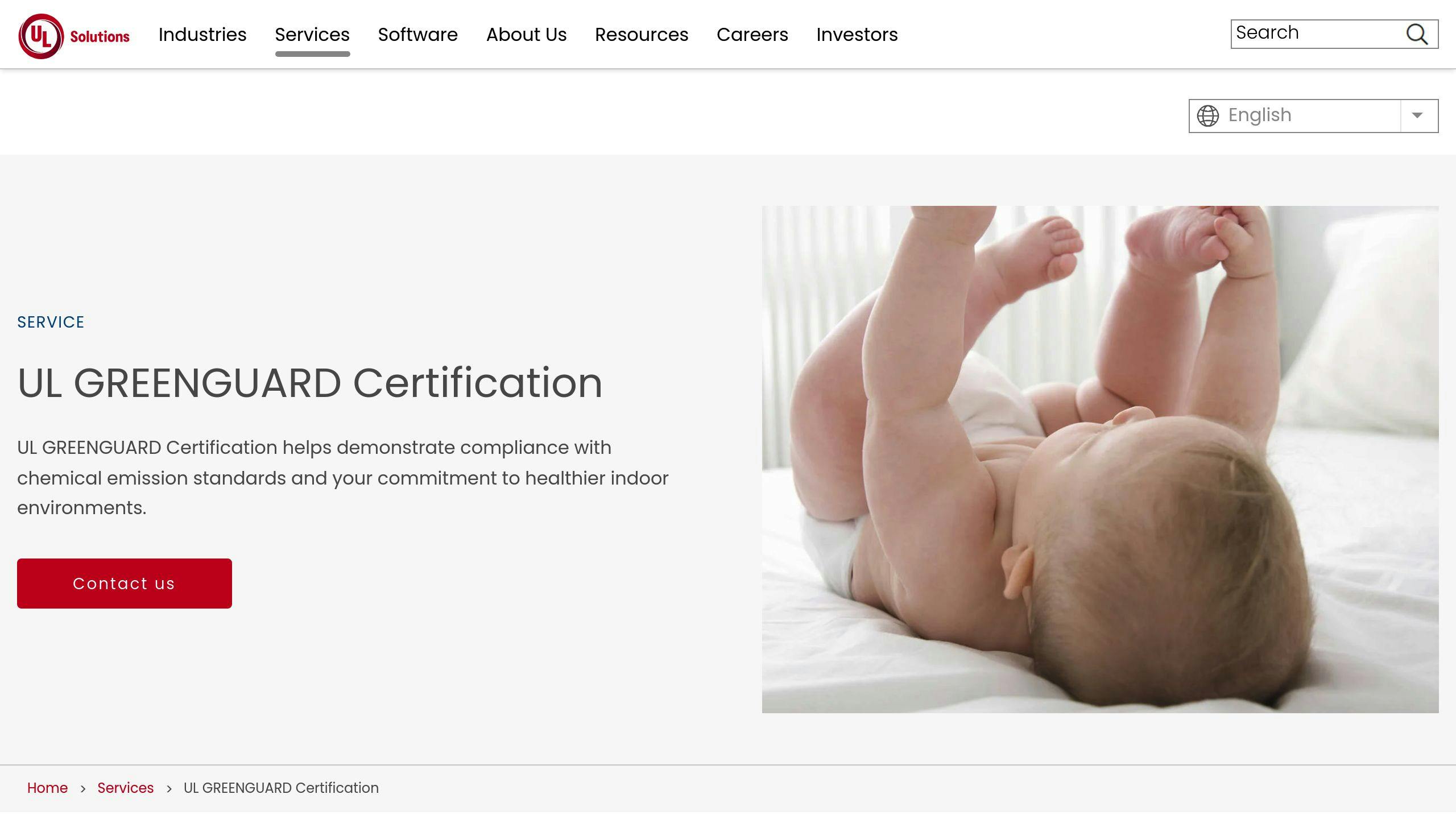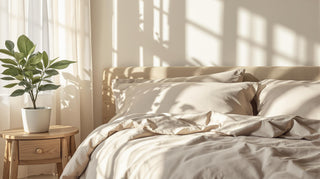Non-toxic bedding is essential for better sleep and health. It avoids harmful chemicals, improves air quality, and supports eco-friendly practices. Here's what you need to know:
- Best Materials: Organic cotton (soft, breathable), bamboo lyocell (moisture-wicking, hypoallergenic), linen (durable, temperature-regulating), and eucalyptus TENCEL (dust mite resistant, eco-conscious).
-
Certifications to Look For:
- GOTS: Guarantees organic materials.
- OEKO-TEX: Tests for harmful substances.
- GREENGUARD: Focuses on low VOC emissions.
- Materials to Avoid: Polyester (releases microplastics, traps heat) and acrylic (poor breathability, emits toxins).
Switching to non-toxic bedding reduces exposure to harmful chemicals, benefits the planet, and enhances sleep quality. Look for certified products like bamboo sheets or TENCEL options for a healthier bedroom.
Say Goodbye to Chemicals with Non-Toxic Bedding Alternatives
Selecting Non-Toxic Bedding Materials
Now that we've covered why non-toxic bedding is important, let's dive into the materials that can help create a healthier and more comfortable sleep environment.
Natural and Organic Options
Natural materials come with a range of health and comfort perks. Here's a quick comparison of some top choices:
| Material | Benefits | Ideal For |
|---|---|---|
| Organic Cotton | Soft, breathable, free of pesticides | Sensitive skin, year-round use |
| Bamboo Lyocell | Moisture-wicking, antimicrobial | Hot sleepers, allergy sufferers |
| Linen | Durable, regulates temperature | All seasons, long-term use |
| Eucalyptus TENCEL | Dust mite resistant, eco-conscious | Humid climates, sensitive skin |
Bamboo, for example, is known for being highly sustainable - it enriches soil and produces more oxygen [2]. Products like Sienna Living's bamboo sheets showcase these benefits, offering hypoallergenic, breathable comfort with an eco-friendly edge.
"In terms of user health, GOTS certification is the most meaningful certification for textiles including beds and bedding made with cotton and polyester", says Corinne Segura, Building Biologist at My Chemical-Free House [1].
Synthetic Materials to Avoid
Some synthetic materials can negatively impact your health and the environment. Here are a couple to steer clear of:
-
Polyester
- Releases microplastics into water during washing
- Made from petrochemicals
- Traps heat and moisture, potentially irritating skin
-
Acrylic
- Contains questionable chemicals
- Poor breathability
- Emits harmful substances, contributing to indoor air pollution
Switching to non-toxic bedding not only reduces chemical exposure but also improves indoor air quality [3]. Materials like TENCEL eucalyptus fibers are a great choice - they're durable, gentle on the skin, and produced through an efficient, low-impact process [2].
Once you've chosen your materials, certifications can help confirm their safety and quality.
Certifications for Non-Toxic Bedding
Choosing the right materials is important, but certifications give you extra confidence in both safety and eco-friendly practices.
GOTS Certification

The Global Organic Textile Standard (GOTS) is one of the top certifications for organic textiles. To earn this certification, products must use at least 95% certified organic materials and meet strict guidelines for both environmental impact and worker welfare.
| GOTS Certification Requirements | What It Means for You |
|---|---|
| Minimum 95% organic materials | Assurance of organic content |
| No harmful chemicals; eco-conscious production | Safer products and greener practices |
| Ethical labor standards | Bedding made under fair working conditions |
OEKO-TEX Certification

OEKO-TEX Standard 100 ensures textiles are tested for harmful substances. According to Sarah Jameson from Green Building Elements, “OEKO-TEX STANDARD 100 is an international testing and certification system for all finished, semi-finished, and raw textile products” [1]. This certification evaluates over 100 harmful substances to meet strict safety standards.
Testing covers areas like:
- Chemicals that could be hazardous
- Dyes and colorants
- Heavy metals
- Formaldehyde content
GREENGUARD Certification

GREENGUARD certification emphasizes indoor air quality, focusing on reducing volatile organic compound (VOC) emissions. For example, brands like Naturepedic combine GREENGUARD Gold and OEKO-TEX Standard 100 certifications to deliver bedding that prioritizes both safety and quality [3].
When shopping for certified bedding, always check for official logos and verify them through certification websites. These steps ensure you're investing in bedding that supports a healthier, toxin-free home.
sbb-itb-a5d8867
Creating a Toxin-Free Bedroom
Transform your bedroom into a safe haven by selecting eco-conscious products, taking proper care of your bedding, and choosing materials designed to last.
Picking Eco-Friendly Brands
Look for brands that use eco-conscious materials and uphold transparent manufacturing practices. Certifications like GOTS and OEKO-TEX can help you identify safe, environmentally responsible options.
| Material Type | Features & Environmental Impact |
|---|---|
| Bamboo Lyocell | Naturally hypoallergenic, resists microbes, and generates 35% more oxygen than trees. |
| TENCEL Lyocell | Fully biodegradable, crafted in a closed-loop system that recycles nearly all water. |
| Organic Cotton | Free of harmful chemicals, breathable, and requires less water for production. |
Caring for Your Bedding
Keeping your bedding clean and well-maintained helps retain its non-toxic properties. Stick to natural detergents that avoid harsh chemicals and synthetic fragrances. Wash bedding weekly and, when possible, air-dry it in sunlight for natural disinfection.
Helpful care tips include:
- Washing regularly to remove allergens like dust mites and dead skin cells.
- Air-drying bedding outdoors to preserve its non-toxic qualities.
- Rotating bedding components to minimize wear.
- Vacuuming mattresses and pillows to keep them fresh and allergen-free.
Choosing Long-Lasting Materials
Invest in materials like bamboo lyocell and TENCEL, known for retaining their non-toxic properties over time. Reinforced seams and warranties are signs of quality when selecting bedding. Regularly rotate your bedding and address signs of wear to ensure it lasts.
Factors that contribute to durability:
- High-quality materials and solid construction.
- Consistent care and cleaning routines.
- Proper storage to prevent damage.
Conclusion
Key Takeaways
Choosing the right bedding plays a big role in creating a healthier sleep environment. Selecting items made from non-toxic materials and certified by organizations like GOTS, OEKO-TEX, and GREENGUARD ensures they meet strict safety and quality standards. Materials like TENCEL and bamboo lyocell show how modern bedding can balance comfort with eco-friendly practices.
These certifications and materials not only make bedding safer for you but also better for the planet. Brands such as Sienna Living highlight how luxury can align with sustainability by offering products made from eco-conscious materials like bamboo lyocell. This fabric, for instance, is naturally antimicrobial and great at wicking moisture, making it both practical and comfortable [2].
Steps Toward Healthier Choices
Switching to non-toxic bedding benefits your health, supports the environment, and delivers lasting value. Start small with certified sheets or pillowcases that suit your needs - bamboo for cooling properties or hypoallergenic options for sensitive skin. Maintaining your bedding with natural cleaning products and proper storage helps keep both its quality and health benefits intact.
Here are some simple ways to create a healthier, toxin-free bedroom:
- Use bedding made from certified non-toxic materials.
- Clean regularly with natural cleaning solutions.
- Store items properly to extend their lifespan.
- Gradually replace frequently used items with safer alternatives.
Opting for eco-friendly materials like TENCEL and bamboo lyocell isn’t just about better sleep - it’s about making choices that positively impact the planet. By investing in these options, you're improving your personal space while contributing to a more sustainable future.
FAQs
What is the healthiest bedding to sleep on?
The healthiest bedding is made from natural, chemical-free materials like organic cotton and linen. These are great for people with sensitive skin or allergies. For added assurance, look for bedding with GOTS certification, which ensures the product contains at least 95% certified organic materials [1].
What are the healthiest materials for bedding?
Here are some top bedding materials and their benefits:
| Material | Benefits | Best For |
|---|---|---|
| Bamboo | Hypoallergenic, soft, moisture-wicking | Hot sleepers, allergy sufferers |
| Organic Cotton | Breathable, durable, chemical-free | Sensitive skin, year-round use |
| Linen | Temperature-regulating, softens over time | All seasons, longevity |
| TENCEL | Eco-friendly, moisture-wicking | Night sweats, eco-conscious buyers |
What is the safest bedding material?
The safest bedding materials come from natural, organic sources. Organic cotton and linen are top choices because they’re free from synthetic chemicals and heavy processing. On the other hand, avoid synthetic materials like acrylic, nylon, and polyester, which may contain harmful substances.
"In terms of user health, GOTS certification is the most meaningful certification for textiles including beds and bedding made with cotton and polyester." - Corinne Segura, Building Biologist, My Chemical-Free House [1]
For peace of mind, choose bedding with OEKO-TEX or GREENGUARD certifications, which ensure safety from harmful chemicals. Brands like Sienna Living offer bamboo bedding that meets these standards while delivering comfort and luxury.

